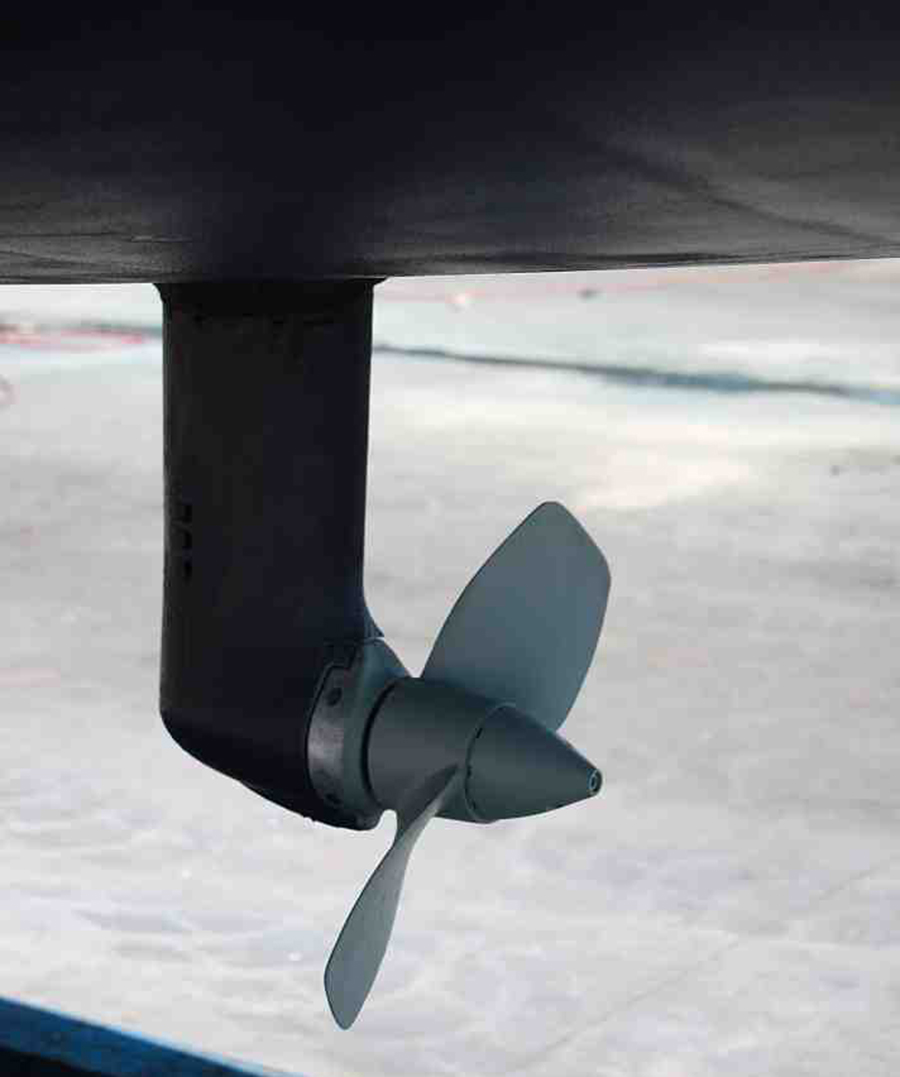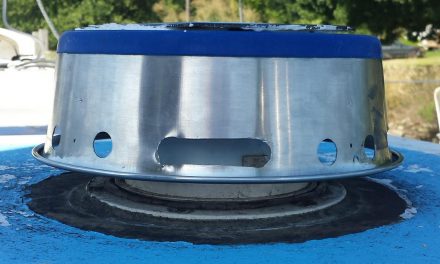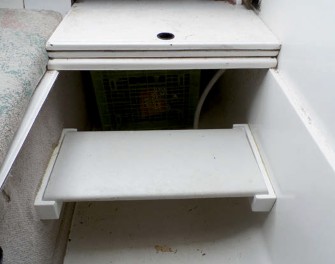Here’s how to give your old ropes a new life.
Issue 140: Sept/Oct 2021
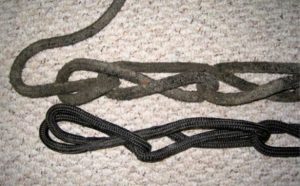
A long soak can make a big difference. This shows two parts of the same rope, but the lower portion was only lightly agitated.
Every sailor has gazed longingly upon the rack of shiny new ropes at the local chandlery, admiring the smooth finishes and imagining how they might improve balky tackles aboard. Thus mesmerized, we buy coils of beautiful line, reeve them with care…and within a few seasons they become stiff and hard, the result of minor UV damage, lost spinning lubricants, and lime deposits that result from repeated soaking and evaporation of seawater. Seldom-used tails grow mildew, algae, and even lichen.
At this point, some folks toss the old rope in the dumpster and buy new (a local rigger told me that he has customers who would sooner replace a line because it was dirty than because it was broken). Others attempt to restore the look and feel of old rope in the washing machine, only to destroy either the washing machine or the rope. Being both an engineer and a cheapskate, I’ve learned how to keep rope looking fresh and stretch its working life to the very limit. Following are some hard-earned tips.
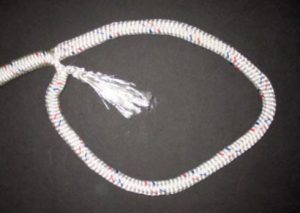
Splices that are not lock-stitched or seized before going into a washing machine commonly fall apart due to the back-and-forth motion during the wash cycle.
Presoak
The key is to soak rope in a bucket with water and detergent before washing. Ropes are thick, and it takes time for water and detergents to soak through, then more time for chemistry to do its magic, loosening dirt. Use hot water and the full detergent dose you intend to use in the wash cycle. Agitate the soaking rope once in a while, over the course of several hours. Also, the long presoak removes heavy soils that may otherwise reduce the porosity of the pillowcase you will want to use if washing in a machine, limiting its effectiveness (more on this below).
Easy on the Infrastructure
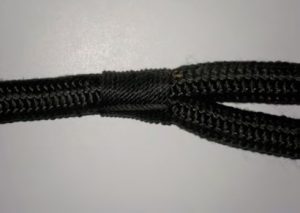
A seized splice is protected from coming undone when washing.
Don’t break the washing machine! This lesson did not come easily; I’ve broken and repaired the machine more than once. These days, I usually skip the machine altogether, preferring to wash ropes in a bucket using hand agitation. The only time I use a machine is when I find a rope in the skip that is in terrible shape.
That said, a washing machine is an effective tool for cleaning and conditioning rope, but only if done the right way. First, in conventional-style machines, ropes can wrap around the central agitator. A New England Ropes tech told me they can bind this agitator and twist the transmission right out. Second, rope fibers are very strong, and in any type of washing machine, stray fibers that separate from the rope during washing can damage pumps and seals.
The solution? Preparation and pillowcases. Before shoving the rope into the pillowcase (don’t coil it), tie a sock over attached shackles and thimbles. Also, whip all rope ends; an end that is simply melted or cut with a hot knife can easily separate. Once your rope is prepped and safely stuffed, close the pillowcase with a zip-tie.

Hernias in new docklines. Drew ruined over 100 feet of rope in minutes by washing this new dockline unprotected (outside of a pillowcase) in a washing machine.
Hernias: They’re Not Just for Humans
When new, marine double-braid covers are loosely woven to allow easy splicing. This is because splicing requires that the rope cover be opened with a fid, extracted, tucked back in, and often stretched over a second cover. But this loose cover that enables splicing can open as a result of the rope getting milked back and forth by the steady rocking induced by the washing machine agitator. Once open, the core can poke out.
As a prelude to a bleach-testing program I once conducted for Practical Sailor, I washed sections of new rope to remove spinning lubricants and to create a universal level of simulated pre-wear. Whether I put the rope into the machine coiled or daisy chained, all of the samples were ruined within 15 minutes on the gentle cycle, herniated every 6 to 12 inches.
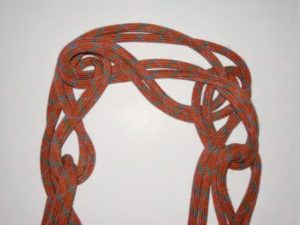
Climbing rope has a tighter cover and is not prone to herniating.
My solution is simple: Never machine-wash a rope until after two seasons have passed. If you must wash a rope when still new, use a bucket and agitate gently by hand.
Woolite and Other Myths
The reasoning behind the oft-repeated advice to use a gentle detergent when washing rope is to reduce the removal of spinning lubes from the rope. That’s it, no other reason. And by the time it’s advised to wash a rope, most of that lubrication is long gone. It should be obvious that no ordinary laundry detergent could harm rope; rope is made from the same fibers used in clothing that we don’t hesitate to wash with a regular detergent. The same is true of hot water—go for it! Nylon and polyester can easily withstand normal laundry temperatures (a heated dryer is another story).
Chlorine Bleach
Don’t do it. Every time you bleach a rope, even using recommended dilutions, you weaken it by two to five percent. The older the rope, the greater the damage. Of course, higher concentrations and extended soak periods cause even more damage. Besides, a long, hot presoak and proper washing is plenty; bleach can’t improve the result much.
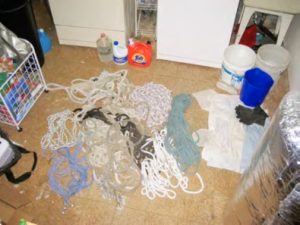
One day’s work of line-washing testing is strewn about Drew’s laundry room floor.
OxiClean
OxiClean is based on the same chemistry (percarbonate) as professional sail-cleaning formulas. When used at the recommended dosage, OxiClean is safe on rope, upholstery, and sails, including laminates. It will remove stains without weakening rope. It requires a four- to six-hour soak time, and it’s not as effective a stain remover as bleach, but rest assured it often does a good job of weakening stains such that a few days in the sun after washing finishes the job. Be patient, your rope will thank you.
Let Sleeping Rust Lie
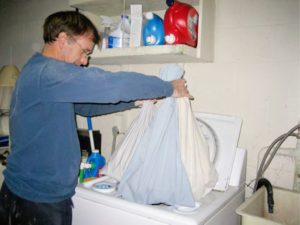
Drew drops lines, safely protected in pillowcases, into the washing machine.
Acid is the usual go-to for rust and other metal stains, but nylon will literally melt in strong acid solutions and may be critically, invisibly damaged by weaker acid solutions. If a rust stain didn’t come out in the laundry, leave it alone.
This is how to make your lines look their best. After a good presoak, a full gentle-cycle washing in hot water—or hand washing in a bucket as I do—should return the rope to acceptable condition. The heavy dirt is gone, the lime crystals chelated and washed away, and any staining greatly reduced.
To make them last practically forever, keep them lubricated and protected from chafe. It works, I know; except for critical roles such as jacklines, tethers, and standing rigging, I acquire nearly all of my rope from the dumpster (it helps to stay near a very high-priced marina!) and then recondition it to near-new.
Good Old Boat Technical Editor Drew Frye draws on his training as a chemical engineer and pastimes of climbing and sailing to solve boat problems. He cruises Chesapeake Bay and the mid-Atlantic coast in his Corsair F-24 trimaran, Fast and Furry-ous, using its shoal draft to venture into less-explored waters. He is most recently author of Rigging Modern Anchors (2018, Seaworthy Publications).
Thank you to Sailrite Enterprises, Inc., for providing free access to back issues of Good Old Boat through intellectual property rights. Sailrite.com



